Postpublished at 18:39 GMT 6 January 2016
We are going to close our live coverage here. You can follow further developments via the BBC World homepage and BBC World Twitter account, external.
North Korea claims it has conducted its first successful test of a hydrogen bomb as tremor detected close to main nuclear test site
Announcement met with both international condemnation - but also scepticism over whether blast was large enough to have been from H-bomb
South Korean ministers are holding an emergency meeting and the UN Security Council will meet later
All times GMT
Becky Branford and Joel Gunter
We are going to close our live coverage here. You can follow further developments via the BBC World homepage and BBC World Twitter account, external.
The UN Security Council meeting has finished. The 15-member council "strongly condemned" the nuclear test and agreed to prepare further unspecified measures against North Korea.
In a statement, the council described Wednesday's test as a "clear threat to international peace and security".
Uruguay's Ambassador Elbio Rosselli, this month's council president, pointed out that the council had, prior to this test, threatened to take "further significant measures" against North Korea if Pyongyang violated existing UN resolutions by testing an atomic device.
"In line with this commitment and the gravity of this violation, the members of the Security Council will begin to work immediately on such measures in a new Security Council resolution," Mr Rosselli said.
He did not specify whether the new measures would extend sanctions against North Korea, but other diplomats confirmed that adding new names to the sanctions list was being considered.
Three previous tests in 2006, 2009 and 2013 triggered waves of UN sanctions against the notoriously secretive and insular country. There are currently a total of 20 entities and 12 individuals on the UN sanctions blacklist.
British Ambassador Matthew Rycroft said his delegation was "working with others on a resolution on further sanctions."
We are going to pause our live coverage for now. The UN Security Council meeting is ongoing. Check the BBC World homepage for developments in the meantime.
Dr Jim Hoare, the former British charge d'affaires to North Korea, has been telling BBC 5 live radio that he believes North Korea could be brought back to the negotiating table, but that it would require everyone to accept that Pyongyang will not completely relinquish its nuclear weapons programme.
Quote MessageI personally don't think they're likely to use it - but they're not going to give it up easily. What they could be persuaded to do, I think, is to go back to something like the thing that existed in the 1990's - the Agreed Framework with the United States, which put a cap on the existing programme and mandate no further development. That lasted some eight years but it was ended by a change of government in the US which didn't believe the North Koreans could be trusted.
Dr Jim Hoare, Former UK charge d'affaires in Pyongyang
Dr Hoare went to say that China - North Korea's key ally, trading partner and lifeline - and Russia could perhaps persuade it back to the table but might have little interest in doing so.
Quote MessageThe trouble is all along that these two big powers aren't really prepared to put real hard pressure on North Korea. Particularly for the Chinese, the existence of North Korea has certain advantages: it keeps the US at bay, it's a buffer, it has economic advantages for them - so to expect China to pull the issue on to the table is a bit hopeful.
Reuters quotes Vitaly Churkin, Russia's ambassador to the UN, calling for "cool heads" and a "proportionate response" to North Korea's test ahead of the Security Council meeting.
The agency says it's been told by Council diplomats that the possibility of expanding existing UN sanctions on Pyongyang will probably be raised.
The UN Security Council meeting is underway. The meeting is closed but we'll bring you any updates from the sidelines
US House Speaker Paul Ryan has said the test appeared to be a provocation but that it was too soon to push for a US response until the facts of the incident were known.
"I think this means we have to have a well-honed response with our allies on this rogue regime," Mr Ryan told reporters at a news conference after a meeting of his Republican Party.
"We don't know the facts yet," he said, adding: "This looks like a provocation."
The BBC's Jonathan Marcus on what's happened and what, if anything, can be done.
Watch the video here.
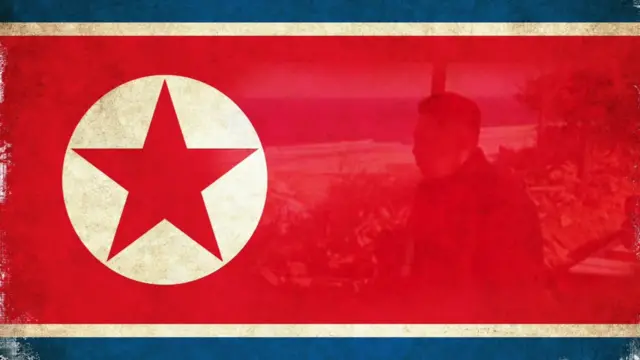
John Everard, the former British ambassador to North Korea, has written a piece for the Telegraph on the likelihood of North Korea ever using its nuclear weapons in anger.
Everard also raises the surprising possibility of the regime retreating to tunnels to wait out a nuclear retaliation.
Quote MessageIt is dangerous to assume that North Korea would never really use a nuclear weapon. Although we may think that this would mean the end of the regime it is not clear whether the regime thinks this. In the strange, closed world of North Korea it is quite possible that the leadership has convinced itself that craven foreigners would not dare to counter-attack if it used a nuclear device. Moreover, North Korea has an elaborate system of defensive tunnels - like Tora Bora in Afghanistan, but much more extensive. If the regime believes that it could retreat to these tunnels and survive a nuclear counter-strike then it will be less reluctant to use its own nuclear weapons.
Read the full piece here, external.
Ban Ki-moon, the United Nations Secretary-General, has joined the chorus of international condemnation, calling the test "deeply troubling" and "profoundly destabilising for regional security."
"This test once again violates numerous Security Council resolutions, despite the united call by the international community to cease such activities," he said.
"It is also a grave contravention of the international norm against nuclear testing.
"I demand the DPRK cease any further nuclear activities and meet its obligations for verifiable de-nuclearisation."
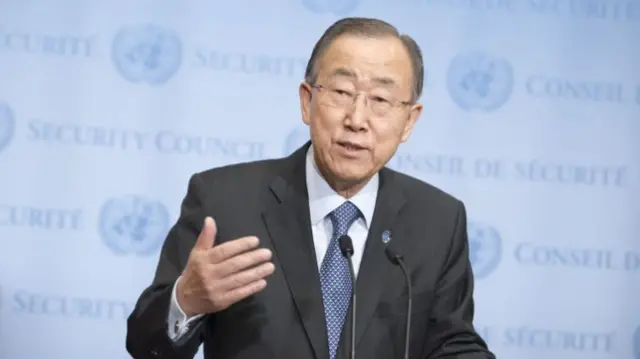 Image source, AFP
Image source, AFPThe Washington Post has produced a handy animated graphic, external showing the size and geographical location of nuclear tests through the decades.
 Image source, Washington Post
Image source, Washington PostHuman Rights Watch reminds us that this test comes just two days before Kim Jong-un's 33rd birthday. But he probably wouldn't appreciate HRW's suggestion for a present:
Quote Message"Kim Jong-un may think it appropriate to celebrate his birthday early with a nuclear test, but even a hydrogen bomb should not cause the world to forget that the Kim family's hereditary dictatorship is built on the systematic brutalization and abuse of the North Korean people. The only birthday present that Kim Jong-un should get from the international community is a one way trip to the International Criminal Court in The Hague, where he should be put on trial for crimes against humanity."
Phil Robertson, Deputy Asia director, Human Rights Watch
Kim Jong-un used his customary restrained style to announce the test to the people of the DPRK. Here is a selection of his remarks:
"The DPRK's access to the H-bomb of justice, standing against the US, the chieftain of aggression ... is the legitimate right of a sovereign state for self-defence and a very just step no one can slander."
"The spectacular success made by the DPRK in the H-bomb test this time is a great deed of history, a historic event of the national significance as it surely guarantees the eternal future of the nation."
"The US is a gang of cruel robbers which has worked hard to bring even a nuclear disaster to the DPRK, not content with having imposed the thrice-cursed and unheard-of political isolation, economic blockade and military pressure on it for the mere reason that it has differing ideology and social system and refuses to yield to the former's ambition for aggression."
There's an hour until the UN Security Council meets to discuss its response to the test.
Five nations will be at the table: South Korea, the US, China, Russia, and Japan, the only non-permanent Security Council member in attendance.
All five nations were involved with the previous, unsuccessful round of talks in 2009, when representatives from North Korea joined them.
South Korean newspaper the Korea Herald tries to unpick Kim Jong-un's motivation, external for the surprise test:
Quote MessageBy elevating its threat of nuclear force, the North is trying to secure a stronger position in its dealings with South Korea, the US and the international community. Internally, Kim, stepping into his fifth year in power, apparently wants to solidify his grip on the country by building his image as a capable leader. This is all the more necessary because he has yet to show his countrymen any notable achievement in the economy. It also should be noted that the Congress of the Workers’ Party - the first of its kind since 1980 - is scheduled for May.
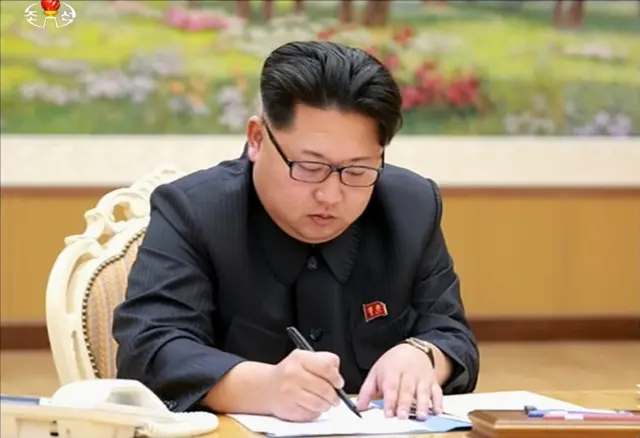 Image source, AFP
Image source, AFPHere, Mr Kim is shown on North Korean TV apparently signing the document authorising the test.
Here are some more images - released by the North Korean state news agency - of apparently jubilant Pyongyang citizens hearing the news of the test.
State media broadcast the announcement on big screens in the capital.
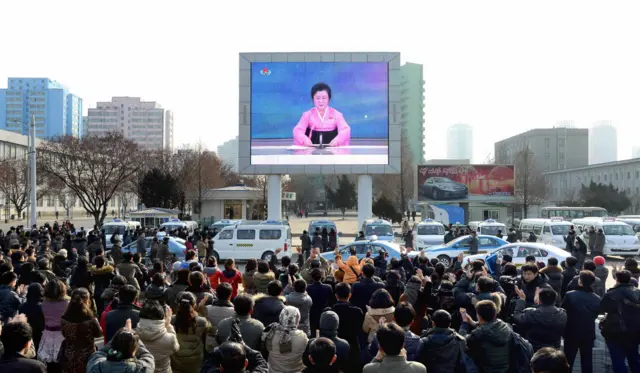 Image source, AFP
Image source, AFPPeople went into the streets to cheer the announcement broadcast on big screens
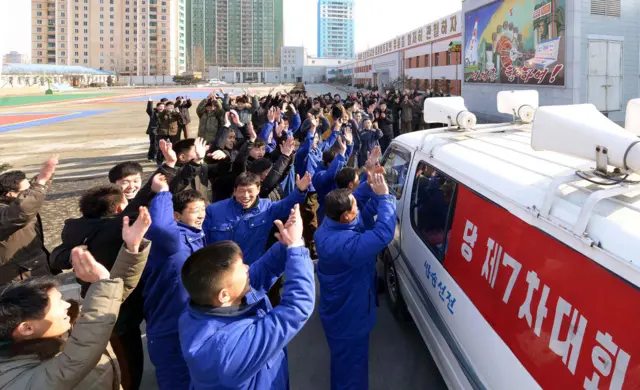 Image source, AFP
Image source, AFPOthers heard the news on loudhailers
 Image source, AFP
Image source, AFPAnd others applauded after gathering in halls to hear the announcement
The first sign of the test was a significant tremor picked up by earthquake detectors in the region - and felt by many in neighbouring China.
The location of the tremor, in the north-east of the country - a part of the world not known for earthquakes but familiar to monitoring agencies as a test site - left little doubt among those in the know as to what had happened.
North Korea's four tests are mapped below.

The announcement of the test on North Korean state TV said it was carried out underground, a common technique for minimising radioactive fallout.
The method also allows for a greater degree of secrecy about the nature and power of the device, which is buried somewhere between 200m - 800m underground.

The nuclear device is placed into a drilled hole or tunnel several metres wide and a lead-lined canister containing monitoring equipment is lowered into the shaft above the chamber.
The hole is then plugged with gravel, sand, gypsum and other fine materials to contain the explosion and fallout underground.
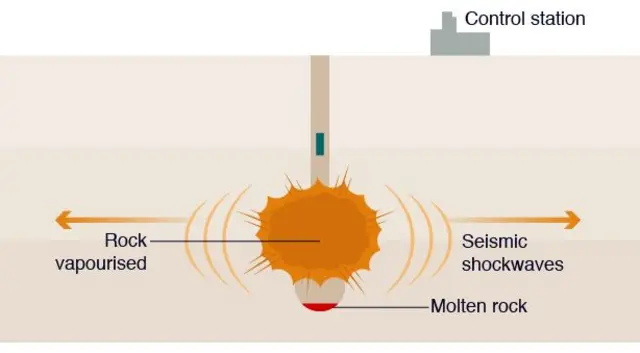
The device is then remotely detonated from a surface control bunker. The nuclear explosion vaporises subterranean rock, creating an underground chamber filled with superheated radioactive gas.
As this cools, a pool of molten rock collects at the bottom of the chamber.
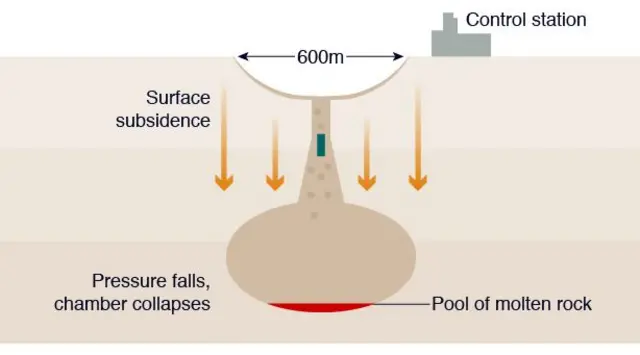
Minutes or hours after the blast, as the pressure falls, the chamber collapses in on itself causing subsidence and a crater to appear on the surface.
The announcement of the test was broadcast on big screens in the North Korean capital Pyongyang.
A reporter for Chinese state news agency Xinhua said residents rushed from their homes to watch the footage of Kim Jong-un and voice their pride in the test.
Allow X content?
This article contains content provided by X. We ask for your permission before anything is loaded, as they may be using cookies and other technologies. You may want to read X’s cookie policy, external and privacy policy, external before accepting. To view this content choose ‘accept and continue’.
The International Atomic Energy Agency has given its response, lamenting the "deeply regrettable" test.
The nuclear watchdog adds: "The IAEA remains ready to contribute to the peaceful resolution of the DPRK nuclear issue by resuming its nuclear verification activities in the DPRK once a political agreement is reached among countries concerned."
We've done a page of international reaction.